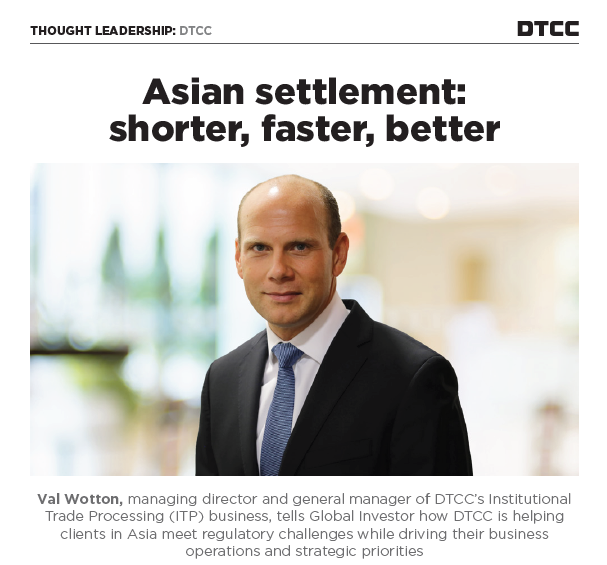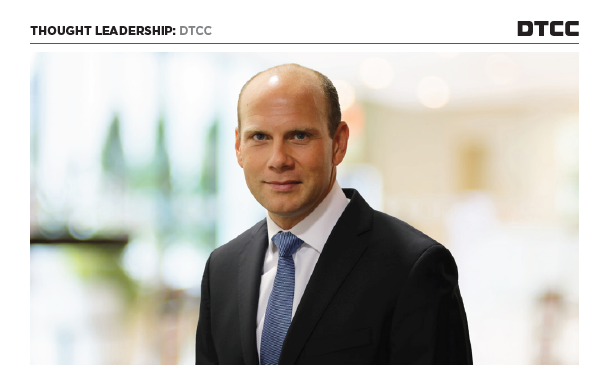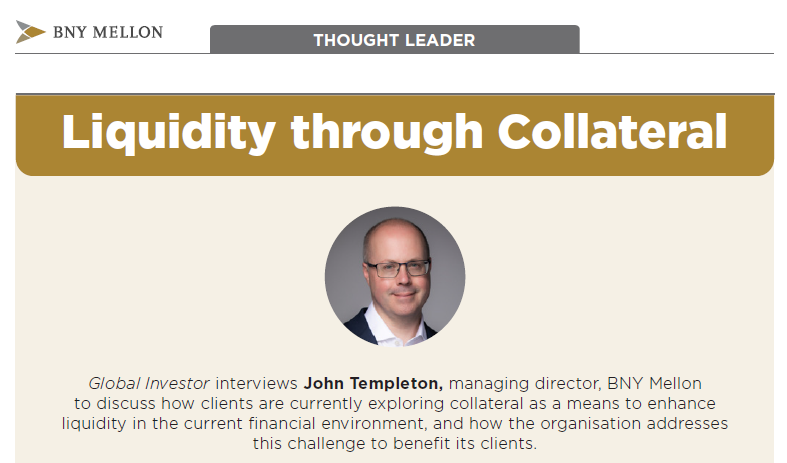Asian settlement: shorter, faster, better

Asian settlement: shorter, faster, better
Val Wotton, managing director and general manager of DTCC’s Institutional Trade Processing (ITP) business, tells Global Investor how DTCC is helping clients in Asia meet regulatory challenges while driving their business operations and strategic priorities.
What are the pressing challenges facing DTCC’s clients in Asia right now?
Across Asia, clients are facing the twin challenges of assimilating significant regulatory change while working to improve straight through- processing (STP) and driving automation across their organisations.
The precise detail regarding tactical implementation varies according to client type and the needs of the individual client. But generally speaking, whether you’re talking to a broker-dealer, an investment manager or a custodian bank, the key question is: How can our firm best achieve regulatory compliance while driving our journey towards a no-touch workflow across the entire lifecycle of the trade?
That means generating effective STP, without anyone in the middle office having to manually touch a transaction, from its execution through matching to affirmation, and all the way through to settlement. The closer you get to this, the further you cut exceptions, breaks, and fails, the more operational efficiency and control you have, and the more overall operational risk is reduced.
How might tighter settlement regimes in the US and Europe affect Asian clients?
Asian markets have a particularly tight focus around accelerated settlement and how to achieve it – whether that is India at T+1 or China that has already moved to T+0. Now there are shifts in the UK and Europe, with both regions set to publish reports on how to achieve a smooth progression to T+1. Central Securities Depositories Regulation (CSDR) is certainly increasing the focus on shortened settlement cycles in Europe.
But the most significant development for Asian clients will be the US move to T+1. Indeed, many APAC markets are considering when and whether or they should move to T+1 to align with the US.
From a client perspective, one of the main challenges is: to accelerate settlement, the timeframe in which to perform confirmation, allocations, affirmation and all the other elements of the trade lifecycle must be compressed. But there’s an added dimension, as there are trades that span regions and time zones.
Now that this process is due to be accelerated to achieve tighter timelines, firms will need to solve the challenges presented by trades that need to be managed across time zones. Obviously, in one sense that may change where the middle office is based. But it brings a new urgency to improving the efficiency of processing, to minimise the number of exceptions and, therefore, the number of manual handoffs.
Therefore, as the ‘follow-thesun’ process that works for 24 hours is perfected, five days per week, the question of how best to leverage STP – including the use of central matching platforms such as CTM® and golden source standing settlement instruction (SSI) platforms such as ALERT® – to help optimise that workflow, becomes paramount.
How are Asian clients prepared for the changes needed to support compressed settlement cycles, compared with those in the US and Europe?
Participants in Asia have a head start in one sense, because many face stricter settlement regimes already. Consider Australia and Singapore (which have mandatory buy-ins), where the overall fail rates are 0.3% and 0.2% respectively.
Strict processes around allocations and more importantly, settlement have steered participants towards more automated solutions, or at least have provided a commercial imperative for these. One example is mandatory buy-in regimes in the case of fails, in China, Hong Kong and Singapore.
So, when considering the wider movement to accelerate settlement and reduce fails, participants in Asia are used to working in a methodical, structured manner. The incentives provided by these measures don’t exist in the US and Europe, where regimes are less strict.
Where Asian transactions involve additional legs in the US and Europe, what will tighter settlement times mean?
We have seen that APAC clients are well prepared from an in-jurisdiction perspective. But when Asian clients are transacting into global markets, they face additional challenges to those encountered when transacting into local markets.
Dealing across borders as that settlement cycle accelerates into T+1 in the US, Europe, and the UK, means careful management across multiple time zones. This includes managing FX and wider, overall funding.
Investment managers will look particularly to custodians and middle office outsource providers, as well as firms providing order management systems, for help navigating this transition. But these providers may not be able to provide the answer entirely.
If a trade is placed on a Friday in Asia that needs to settle in T+1 but involves elements in the US or Europe, and there is no presence in those regions, there may be a requirement for someone from the middle office or the trading team to be available on a Saturday in case something goes wrong – a possibility that clients in Asia are very aware of.
What implications do tighter settlement regimes have for the currency component of a trade?
Many clients are looking closely now at Continuous Linked Settlement (CLS) cut-off times, and whether they will be able to make these. Historically, the market has been very focused on having FX payments going through CLS, which reduces FX risk and operational risk more broadly. But if it’s not possible to achieve those cut offs, what is the solution? One possible solution is pre-funding accounts. However, this may have an impact on how you manage your overall book.
If CLS is not being utilised, the alternative is for that central payment mechanism, to move to bilateral settlement. This brings its own risks, including securities fails or FX fails, meaning cash breaks. Because, if you’re not using services like ALERT, DTCC’s aforementioned database for the maintenance and communication of account and standing settlement instructions (SSIs) call-backs will be necessary as part of a manual process to settle FX transactions.
Do shorter settlement cycles have any other knock-on effects for wider inventory management?
Yes, this final piece probably applies more on the broker-dealer side – specifically how stock-borrow loans are managed. Therefore, if a loaned stock is required to be recalled because the manager has sold it, how can it be ensured that settlement completion is achieved within the new, compressed settlement window?
For clients in Asia trading into US markets, again, that tighter window in which to address fails brings the added challenge posed by trades crossing time zones.
Consider, too, that the tighter rules in the US now include a revised affirmation timeframe: the deadline of 11:30 pm ET on T+1 has now been brought forward to 9:00 pm ET on the trade date
What other elements of the trade lifecycle pose challenges for Asian clients moving to tighter settlement cycles?
One more nuance that distinguishes the US from global markets is around the affirmation process. In the US, confirmation works by the investment manager executing an order or block, that is then confirmed by a brokerdealer before the investment manager provides the detail on how to allocate the block out to the sub-funds – instructions that are then confirmed or matched within DTCC’s CTM.
But in the US there is also an affirmation process, where the brokerdealer submits the trade into an application called TradeSuite ID, here at DTCC. This allows the custodian or the prime broker to affirm that transaction, thereby agreeing all the settlement instructions, and accounts, at the depository – whether it is DTC or NSCC. Thereafter, the system triggers the settlement message into the depository itself. As such it is very similar to the pre-matching process that happens across the globe.
In preparation for the US move to T+1, DTCC has automated this affirmation process after the confirmation, through a workflow within CTM called Match to Instruct (M2i). The adoption of CTM’s M2i workflow, which involves subscriptions to CTM, TradeSuite ID, and SSI enrichment via ALERT, automatically triggers trade affirmation and the delivery of instructions for DTC-eligible securities directly to the DTC for settlement when a trade match occurs between an investment manager and executing broker. By automating the allocation, confirmation and affirmation processes, clients can significantly reduce the time required to stage trades for settlement at the DTC.
The point to emphasise is that many investment managers in Asia, whose custodians have looked after this, with the implementation of T+1 will have to be aware of the time frames, since custodians may bring this forward to ensure the tighter deadlines are met.
Here at DTCC, for example, with the new 9:00 pm ET cut off, it is recommended that allocations are confirmed by a best-practice time of 7:00 pm ET to ensure there is sufficient time to address any exceptions. Investment management firms need to discuss with their custodians the question of whether their custodian will add any further time windows for resolution in their timelines.
Could tighter settlement times have implications for how investment managers are charged?
Tighter settlement cycle regimes place investment managers’ internal procedures under greater pressure. They could turn the traditional scrutiny of broker-dealers by investment managers on its head, as broker-dealers more closely scrutinise investment managers’ internal processes, to identify any blockages that might imperil processing inside the tighter time frames.
Broker-dealers with investment manager clients that leverage best-inclass technology to achieve STP on their trade lifecycle from end-to-end, will benefit from this. As such, this will create implications for how much it costs broker-dealer to service clients and could even raise the possibility of incentivised pricing for investment managers.
In theory, investment managers with higher levels of automation will place less burden on the custodian or outsource provider. This commercial pressure may drive providers to move to differential pricing in some cases.
Found this useful?
Take a complimentary trial of the FOW Marketing Intelligence Platform – the comprehensive source of news and analysis across the buy- and sell- side.
Gain access to:
- A single source of in-depth news, insight and analysis across Asset Management, Securities Finance, Custody, Fund Services and Derivatives
- Our interactive database, optimized to enable you to summarise data and build graphs outlining market activity
- Exclusive whitepapers, supplements and industry analysis curated and published by Futures & Options World
- Breaking news, daily and weekly alerts on the markets most relevant to you




